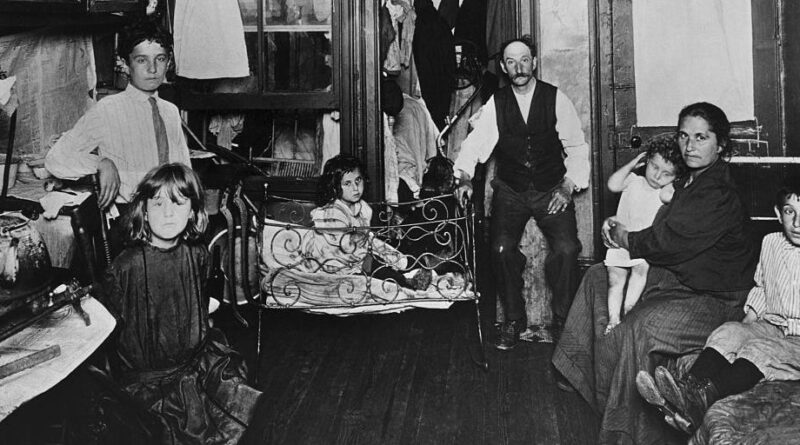Photos show the extreme inequality between rich and poor Americans during the Gilded Age
2025-07-24T13:10:01Z
subscribers. Become an Insider
and start reading now.
Have an account? .
- The Gilded Age was a period of enormous wealth for some and extreme poverty for others.
- Photos show how the poor lived in cramped tenements while the rich built multiple mansions.
- The Gilded Age’s wealth inequality eventually led to reforms in the Progressive Era.
All that glitters is not gold.
The Gilded Agea period of rapid industrialization and extravagant displays of wealth, gets its name from Mark Twain’s 1873 novel about greed and corruption.
While gilded ceilings and furnishings are coated in gold, appearing shiny and luxurious, they serve as a metaphor for the dark underbelly of exploitation and inequality that allowed the richest 0.01% of Americans to hold 9% of the country’s wealth by monopolizing entire industries while the poor sank deeper into poverty.
Photos show the gaping economic disparities that existed during the Gilded Age.
During the Gilded Age, Fifth Avenue in New York City was known as “Millionaires’ Row.”
Geo. P. Hall & Son/The New York Historical Society/Getty Images
Wealthy families like the Astors, the Goulds, and the Vanderbilts built enormous homes on “Millionaires’ Row” modeled after European palaces and chateaus to display their riches.
Manhattan’s Eighth Avenue, however, was full of slum dwellings.
Graphic House/Archive Photos/Getty Images
An 1865 report by the Council of Hygiene and Public Health of the Citizens’ Association of New York found that 65% of the population of New York City was living in “substandard housing conditions,” according to the New York Public Library.
Members of high society owned several homes and rotated between them throughout the year.
Bettmann Archive/Contributor/Getty Images
Newport, Rhode Island, was a popular location for summer “cottages” like The Breakersa 138,300-square-foot mansion built by Cornelius Vanderbilt II, and Marble House, a mansion with 140,000 square feet of living space built by William K. Vanderbilt and Alva Vanderbilt.
Meanwhile, many itinerant workers experienced homelessness.
Bettmann Archive/Contributor/Getty Images
The term “homelessness” was used in the US for the first time during the Gilded Age in the 1870s, according to a 2018 study published by the National Academies of Sciences, Engineering, and Medicine. The rapid period of urbanization and industrialization made some business tycoons rich and spurred others from less fortunate circumstances to move to cities in search of work, where they slept in shelters or on the streets.
Gilded Age mansions featured dozens of rooms for entertaining, dining, and sleeping.
Bettmann Archive/Contributor/Getty Images
The Breakers mansion, which was completed in 1895, featured 70 rooms, including the Great Hall, Billiard Room, Music Room, Morning Room, and Library, as well as bedrooms for the Vanderbilts and their 40 staff members.
In New York City’s tenement apartments, entire families crammed into one room.
Bettmann Archive/Contributor/Getty Images
The poor hygiene, sanitation, and ventilation in tenement dwellings made disease outbreaks spread quickly.
Photographer Jacob Riis documented the squalid conditions in slums and tenements in New York City, which he published in a book titled “How the Other Half Lives” in 1890.
Business tycoons like Jay Gould commuted to their New York City offices via train or steam yacht.
Interim Archives/Getty Images
Gould refused to ride the railroad tracks near his Lyndhurst Mansion estate in Tarrytown, New York, because they were owned by his archrivals, the Vanderbilts. Instead, he commuted into New York City via the Hudson River on his steam yacht, the Atalanta, with his 100-pound Wooton desk in tow.
Others worked in sweatshops.
Hulton Deutsch Collection/Corbis via Getty Images
In addition to photographing tenements and slums, Riis took photos of sweatshops to show the difficult conditions workers endured.
Members of high society attended galas at opulent settings like the Hotel Astor.
Archive Photos/Getty Images
The Hotel Astor was built in Times Square in 1905 after the neighboring Waldorf and Astoria hotels merged into the Waldorf Astoria in 1897.
Hotel staff members who kept the silver gleaming and the liquor flowing remained largely out of sight.
Museum of the City of New York/Byron Collection/Getty Images
Workers were photographed buffing and polishing silver tableware in the kitchens of the Hotel Astor in 1905.
Children of the wealthy, like Consuelo Vanderbilt, lived privileged lives, though they didn’t always have personal autonomy.
Library of Congress/Corbis/VCG via Getty Images
Consuelo Vanderbilt, daughter of William K. Vanderbilt and Alva Vanderbiltgrew up in the height of luxury, but was largely dominated by her mother. In 1895, Alva Vanderbilt forced her daughter to marry the Duke of Marlborough despite her love for another man.
Among poor populations, child labor was commonplace.
Jacob August rice/library of Congress/Corbis/VCG Via Getty Images
Around 18% of children aged between 10 and 15 in the US were employed between 1890 and 1910, according to the Bureau of Labor Statisticsoften in factory and mining jobs.
The extreme inequality of the Gilded Age led to political and social reforms in the Progressive Era that followed.
PhotoQuest/Getty Images
The Progressive Era ushered in changes such as women’s suffrage, labor unions, and laws such as the Clayton Antitrust Act designed to prevent a select few companies from amassing monopolies. The age of the “robber baron” began to fade, and their mansions on “Millionaires’ Row” were torn down to make room for New York City’s continuing expansion.




